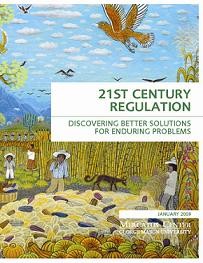- | Regulation Regulation
- | Research Papers Research Papers
- |
21st Century Regulation: Discovering Better Solutions to Enduring Problems
This publication is the first in a new series of long-term research and discussions focused on finding solutions to the most pressing regulatory hurdles. This compendium consists of five papers

In this publication, you will find five papers by leading scholars in the Mercatus Center’s academic network. These papers examine various reforms and new approaches to regulation for the new presidency and the federal government to consider.
Performance Accountability for Regulations
by Henry Wray
An existing statute, the Government Performance and Results Act (GPRA), legislates accountability by federal agencies for the results (or lack thereof) achieved with tax dollars. The GPRA requires agencies to create comprehensive plans that include five-year goals and objectives (including outcome-related ones) and to measure and report their progress toward those goals to Congress and to the public every year. A new executive order could apply these requirements directly to important federal rules.
This paper first discusses the limitations of the existing system, then presents a framework for the new executive order. That framework includes (1) performance metrics for rules, (2) consultation with stakeholders and the Office of Management and Budget (OMB) review, (3) performance reporting, (4) guidelines for which rules would be covered, and (5) guidelines for which agencies would be covered. It then discusses how to bring a new executive order from mere implementation to actual success through two key steps: incentives to agency managers to support outcome-oriented performance measurement and accountability and ongoing stakeholder participation in the development and performance monitoring of the new goals and measures. Finally, this paper considers the likely challenges in the application of this accountability framework to the rules, offers suggestions for overcoming them, and proposes that the potential benefits of successful implementation could include a more transparent and accountable federal government, increased public confidence, and better rules that deliver superior results.
Improving the Regulatory Process Throughout its Life Cycle:
Nine Recommendations to a New Administration
by Scott Farrow
This paper sets out a life-cycle view of the regulatory process with suggested changes for the near and longer term. The life cycle begins with the strategic goals that government hopes to achieve, proceeds through several steps to the implementation and monitoring of a regulation, and continues to evolve over time. This paper provides nine distinct recommendations along with their purposes, backgrounds, reasons for adoption and challenges to implementation. A new administration in 2009 will have the option to change executive-branch aspects of the regulatory process and may work with Congress to improve regulation.
Facilitated Market Solutions for Social Problems
by Richard A. Williams and Andrew Perraut
This paper explains how the facilitated market solution process begins, who pays for the negotiation, what measures are taken to ensure that all affected parties are represented, how the process differs from regulatory negotiation, and how this method falls short. It then discusses an existing issue, that of improving health labeling on packaged food products, and how it is being handled through this process by a nonprofit intermediary (the Keystone Center).
Rethinking Protection of Competition and Competitors
by Bruce Yandle
The paper analyzes government involvement in the delicate balance between competition and regulation and offers recommendations for improvement. Focusing first on the incentives included in the various regulatory approaches that government might develop for accomplishing a given regulatory goal, this paper recommends that government always attempt to avoid specifying technology-based standards and favor instead goal-oriented rules that focus on outcomes and not on regulatory inputs.
Lessons for New Technologies
by Gary E. Marchant
Emerging technologies such as biotechnology, nanotechnology, and several others have the potential to provide enormous economic, environmental, and health benefits. Yet, the discriminatory treatment and stigmatization of these technologies by regulators, sensationalized media coverage, and activist campaigns are blocking or restricting these benefits.
This paper considers the short history of such technologies—in particular the technologies of genetically modified foods, nanotechnology, and food irradiation—and the regulatory pressures placed upon them. It concludes that the exotic nature of these emerging technologies, media sensationalism, and activist campaigns create “risk cascades” that sensationalize and amplify the risk of some technologies to the point of stigmatization. Such stigmatization results in regulatory double standards that are unfair to the developers of beneficial new technologies and detrimental to public health and welfare.

